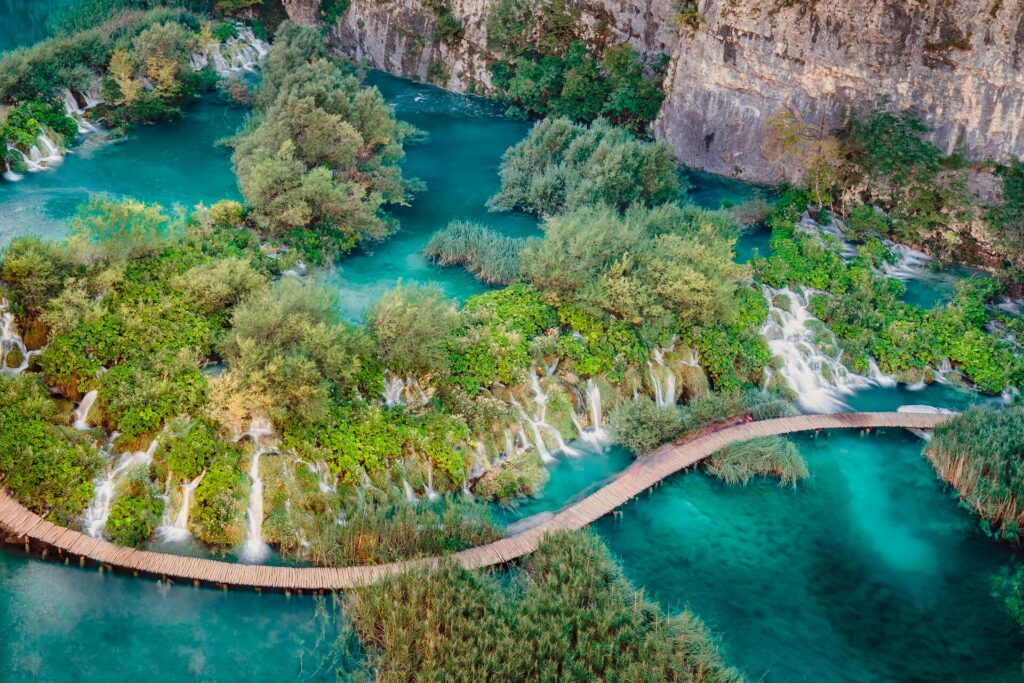15 Best Things to do in Croatia: Essential Sights and Activities
Plitvice Lakes National Park: Everything You Need to Know Before You Go
Croatia’s jewel of natural wonder, Plitvice Lakes National Park, is renowned for its stunning series of cascading lakes and magnificent waterfalls. The park’s unique landscape was formed over thousands of years through the erosive power of water on the region’s limestone and dolomite terrain, creating a mesmerizing network of 16 interconnected lakes.
This UNESCO World Heritage Site is a must-see destination and is a highlight of our Croatia guided tours. The lakes shine with brilliant blues and greens and are connected by a series of waterfalls and rapids, offering sensational views at every turn. Before you head off to Plitvice Lakes to see Croatia’s most famous natural treasure for yourself, we’ve put together a handy guide of everything you need to know before you go.
1. What is the best month to visit Plitvice Lakes?
The best time to visit Plitvice Lakes National Park depends on your preferences for scenery and outdoor experiences, as each season offers a unique perspective of this stunning natural wonder. Overall, May and September are considered the best months to visit.
Generally, late spring (May and June) offers mild weather and fewer crowds. The park’s waterfalls are at their fullest during this time, and the emerging flora adds to the beauty. Summer (July and August) is peak tourist season with warm weather; although Plitvice Lakes operates a quota system for visitors, this is when you will see the largest crowds.
Early fall (September and October) provides cooler temperatures and stunning autumn foliage, making it ideal for photography and peaceful walks. In winter, from December to February, although the large lakes rarely freeze completely, smaller lakes and waterfalls can become icy, and snow blankets the park, creating a beautiful winter wonderland. Note, however, that some trails may be closed due to weather conditions.
2. Where is Plitvice Lakes National Park?
Plitvice Lakes National Park is located in Croatia, situated in the mountainous region of central Croatia near the border with Bosnia and Herzegovina. Covering approximately 295 square kilometers, the park lies about 135 kilometers south of Zagreb, the Croatian capital, making it accessible for travelers exploring Croatia’s mainland.
The region features a diverse ecosystem, with dense forests, endemic plant species, and various animal species including bears, wolves and rare birdlife. The park’s scenic beauty and ecological significance have made it one of Croatia’s most popular tourist destinations and a UNESCO World Heritage Site since 1979.
3. How was Plitvice Lakes formed?
Plitvice Lakes National Park was formed over thousands of years through the natural process of water erosion. The park’s unique landscape was created as water from rainfall and melting snow continually flowed over the region’s limestone and dolomite terrain. This persistent erosive action gradually shaped the area’s characteristic features, including the formation of numerous lakes, waterfalls, and cascades.
As the water moved over the limestone, it deposited minerals like calcium carbonate, which built up over time to form tufa barriers—natural dams that separate the lakes and create the park’s distinctive terraced lakes and waterfalls. The combination of geological processes and the constant movement of water has resulted in the mesmerizing network of 16 interconnected lakes, and one of the most beautiful and dynamic natural landscapes in Croatia.
4. How to get to Plitvice Lakes National Park
Getting to Plitvice Lakes National Park is relatively straightforward and offers multiple options. The most common way is by car, as it provides flexibility to explore surrounding areas and nearby attractions. The park is about a 2 to 2.5-hour drive from Zagreb, via the A1 motorway, which is well-maintained. Rental cars are available at Zagreb Airport or in the city, making travel convenient.
Public transportation options include buses; daily buses run regularly from Zagreb, Split, Zadar, and other Croatian cities directly to Plitvice. The bus journey from Zagreb takes approximately 2 to 2.5 hours.
For international travelers, arriving via nearby airports such as Zagreb or Zadar is practical. Organized tours and shuttle services are also available from major Croatian cities and hotels, offering guided visits with transportation included.
5. How can I see Plitvice Lakes with Insight Vacations?
Want to see Plitvice Lakes in style? This stunning UNESCO World Heritage Site is a key destination on our Eastern Capitals & The Dalmatian Riviera, The Eastern Discovery and Country Roads of Croatia premium tours.
As a MAKE TRAVEL MATTER® Experience, you can join a local expert to explore the park. Learn about ongoing studies to monitor and protect the natural habitat, as well as educational initiatives focused on the marine environment and sustainable practices for a low-impact visit.
The site is actively involved in habitat restoration and constantly works to preserve the park’s natural ecosystems and wildlife. The staff passionately share their knowledge of local traditions and personal stories of the village, offering visitors a meaningful and authentic connection to the area. This experience advances UN Sustainable Development Goal 14: Life Below Water, UN Sustainable Development Goal 15: Life On Land.
6. What is the closest city to Plitvice Lakes National Park?
The nearest airports and largest cities are Zagreb and Zadar. The distance of the Park from Zagreb is 130 km (about 2 hours drive) and from Zadar is 118 km (about 1.5 hours drive).
Zagreb, Croatia’s capital, is a lively city known for its historic architecture, vibrant café culture and attractions such as the Zagreb Cathedral, Ban Jelačić Square and the medieval Upper Town. This is the most common point of entry for international visitors, and close enough for day trips to Plitvice Lakes.
Zadar is a historic coastal city famous for its Roman and Venetian ruins, the unique Sea Organ, and the Sun Salutation installation, offering stunning views of the Adriatic Sea.
7. How long do you need at Plitvice Lakes National Park?
To fully experience Plitvice Lakes National Park, it is recommended to allocate at least 4 to 6 hours, especially if you wish to explore the main hiking trails, waterfalls and lakes thoroughly. Most visitors spend about half a day, but for a more relaxed visit, including taking time for photography, enjoying a picnic, or visiting the park’s visitor center, plan on a full day. The park features a network of wooden pathways and trails that vary in length and difficulty, allowing you to tailor your experience depending on how much time you have allocated. Guided tours are also available, lasting around 4 hours on average.
The park is vast, covering a total area of 296.85 square kilometers (114.61 square miles) so there is the opportunity to take more time, stay overnight locally and explore in more detail for true nature enthusiasts.
Save up to $3,000* per couple on your first Premium Tour
Plus receive latest offers, travel inspiration, and discover how your travels will make a positive impact. Together, WE MAKE TRAVEL MATTER®. Subscribe Now8. What to do in Plitvice Lakes National Park
Visit the Visitor Center:
Learn more about the park’s natural history, pick up maps, and get information on the best routes and activities.
Hiking and Walking Trails:
Explore a network of well-marked trails that wind through the park’s stunning landscapes, offering breathtaking views of the cascading lakes, waterfalls, and lush forests. The wooden pathways make it easy to access various viewpoints and natural wonders.
Boat Rides:
Take a scenic electric boat tour across some of the lakes to experience the beauty from a different perspective. This is a relaxing way to enjoy the park’s tranquil waters.
Photography:
Capture the incredible scenery—vivid blue and green lakes, powerful waterfalls, and diverse wildlife make for perfect photo opportunities.
Wildlife Watching:
The park is home to diverse species of animals and birds. Keep an eye out for deer, brown bears, and various bird species as you explore.
Educational Tours:
Join guided tours or educational programs to learn about the park’s unique geology, flora, fauna, and conservation efforts.
9. Plitvice Lakes National Park admission tickets and fees
The most up to date information on tickets and admissions is availbale on the Plitvice Lakes National Park website.
To see Croatia in premium style take a look at our Croatia guided tours.
LIKED THIS POST? SHARE WITH YOUR COMMUNITY






